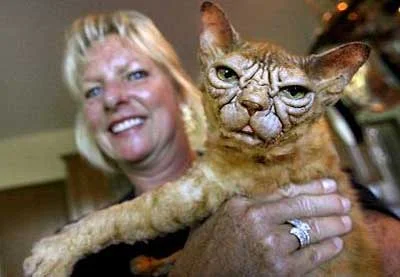A series of pictures and accompanying words that describe some milestones in the history of the cat. We have to start at the beginning, which is the era when the cat did not exist on the planet. Of course, the first cats were wildcats and it stayed that way for millions of years until relatively recently.
This first cat history picture shows the complete development from the animal that was the precursor to the cat, the Miacid, to a highly selectively bred purebred cat in this case a
Snowshoe cat - but it could be anyone of the well established
cat breeds in the picture.
The time frame from the bottom picture to the top picture is about 60,000,000 years (60m or 60 Ma).
It is believed that the genus Felis (
Felis lunensis - Martelli's Cat) appeared about 12 million years ago. 2.4 million years ago the ancestor to the European wild cat appeared.
The Near-eastern wildcat or African wildcat was first domesticated about 9,500 years ago we think so you can see how relatively recent the domestic cat is. Read more on
domestic cat history.
The earliest recorded lion fossil is dated about 3.5 million years ago. The picture, left is of a lion in cave paintings from the Palaeolithic period (2.6 million years ago - 10,000 years ago).
However, the history of the big cats is not certain. It is thought by some that the lion appeared in African about 1 million years ago.
Jaguars roamed over Europe about 1.64 million years ago. See
history of the big cats.
Jumping forward to relatively modern times, the picture left shows the domestic cat in Ancient Egyptian times 1400 BC - almost 3,500 years ago.
The picture shows a slice of cat history. It appears to be of a domesticated or semi-domesticated cat, the precursor of today's Egyptian Mau purebred cat, catching a bird. It appears that the cat was trained by the person in the picture to do this.
Cheetahs were also trained to hunt (16th century)
The Ancient Egyptians had a long and close relationship with the domestic cat and
worshiped the cat at one time for a period of 2,000 years. The cat was first domesticated in the Fertile Crescent, which includes the Nile delta in Egypt.
Above : picture of a statue of the goddess Bastet from the temple of Queen Berenice, who was the wife of King Ptolemy III (246-222 BC). Location: Alexandria, Egypt.
See post.
Bastet festivals were popular until about AD 390. People made sacrifices to the god. Cats were killed for the purpose. Were the Egyptians truly cat lovers?
It seems not. See
Egyptian cat art.
Moving to modern times, cat history now is more about the development of the cat fancy and the cat breeds.
The picture left is of a champion purebred show cat, CHAMPION FULMER ZAIDA, of 1902. The cat fancy started not long before that in the late 1800s in England, UK. See
Persian cat history. Development of new breeds has now, 2012, all but stopped.
However, the most pressing aspect of cat history for us today (2012) is not about the domestic cat but the wild cats and pressingly the demise of the tiger in the wild.
The tiger is heading for extinction and quite rapidly as the human population expands equally rapidly.
The extinction of the tiger (and the other wildcat species) began in earnest in the mid 1800s to early 1900s when they were shot for sport or skins. Poaching of the now rare tiger for tiger body parts to supply the Chinese medicine market (see e.g.
tiger bone) continues today and is the biggest threat together with habitat loss. Ironically, as the tiger becomes rarer its bones become more precious to the commercial market and thus it is more likely to be shot or poisoned and dissected for its body parts.
At that time artists had the habit of
anthropomorphizing the wildcats in drawings. See
Tiger for a lot more.

































